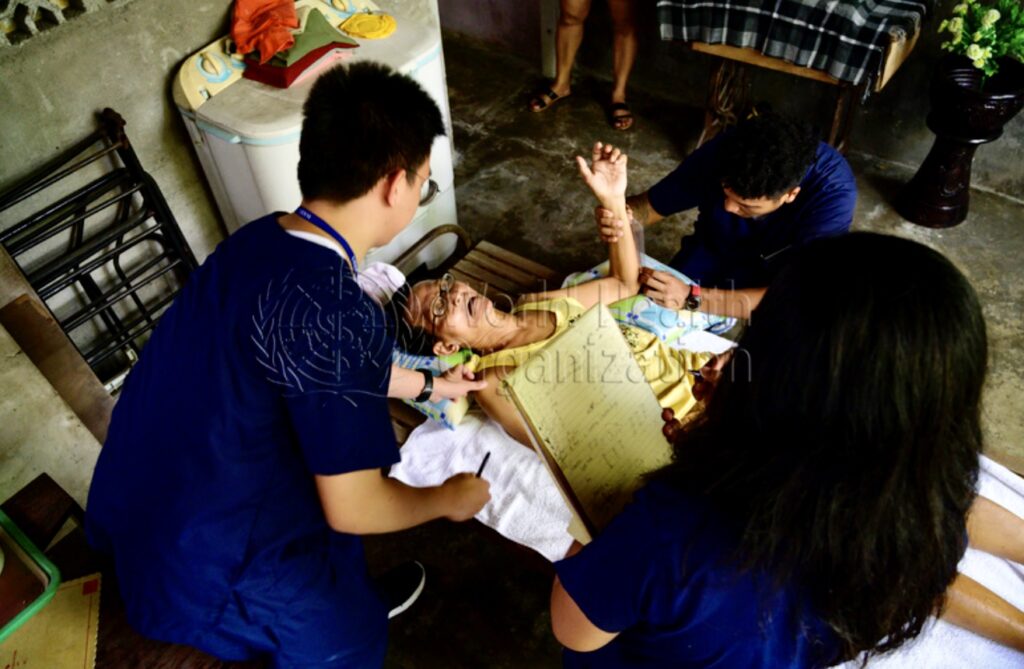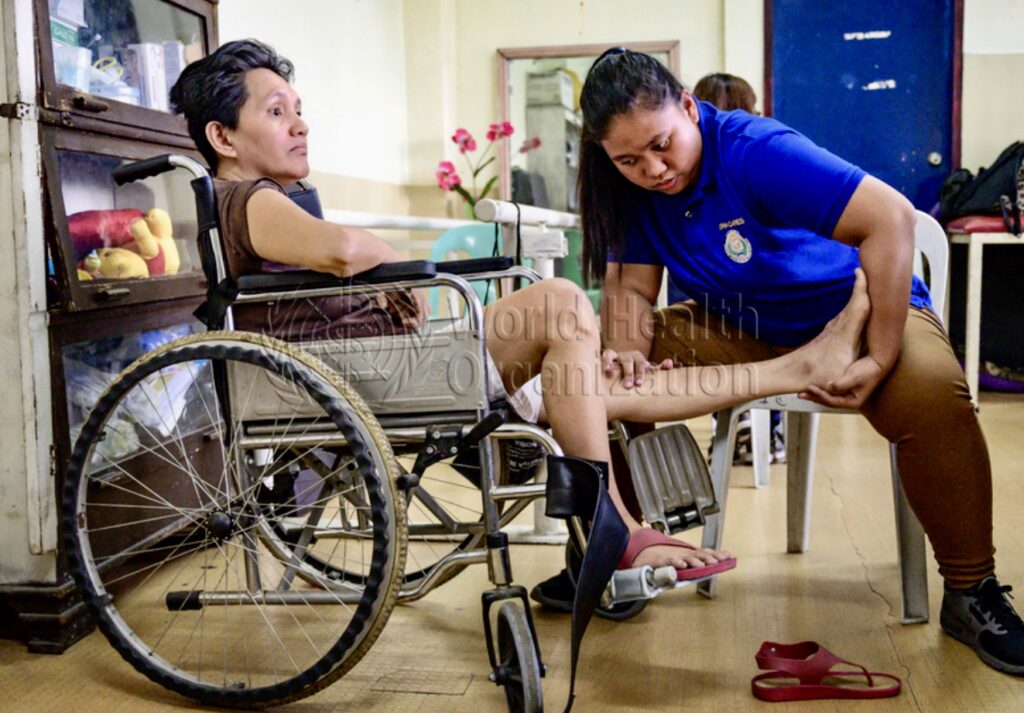By Henrylito D. Tacio
Photos courtesy of WHO
At the age of 24, Romulo Valles has ordained a priest. He was already 46 when he was elevated to a bishop. In 2017, he was elected as president of the Catholic Bishops’ Conference of the Philippines. He was re-elected to the same position in 2019.
Last May 23, at the height of the coronavirus disease 2019 (COVID-19) pandemic, Valles suffered a mild stroke and was confined to the hospital until July 6.
“I still keep the cane but I can walk already but I’m still perfecting my walk,” he said in his public appearance when he celebrated the thanksgiving Mass in line with the start of the Kadayawan Festival at the San Pedro Cathedral. “I think I am progressing well. I’m still practicing how to kneel but I’m halfway there.”
They kept his condition a secret. While at the hospital, he admitted that death was what he was thinking of. “It was no small sickness,” the 69-year-old prelate said as half of his body was paralyzed, and his speech and swallowing were affected. “I thought of a great possibility of dying.”

While most people are afraid of COVID-19 these days, they have forgotten that stroke is deadlier. In fact, stroke is the second leading cause of death in the country today and ranks fifth among those with the greatest disease burden.
In the time of this pandemic, stroke is even more prevalent than ever. Medscape Medical News reported on a letter published in the New England Journal of Medicine which described five COVID-19 patients under the age of 50 who suffered large vessel strokes over a 2-week period.
Dr. Thomas Oxley, from the Department of Neurosurgery at Mount Sinai Health System in New York, who led the study, was quoted as saying: “We’re learning that this can disproportionately affect large vessels more than small vessels in terms of presentation of stroke.”
But it’s not only in the United States where an increased risk of clotting seen in young COVID-19 patients was observed; it also happened in China, France, and Italy.
“It appears that the underlying cause of stroke in young patients with coronavirus are cerebral emboli,” Dr. Andrew Rogove, medical director of the Stroke Services at Northwell Health’s Southside Hospital in Bay Shore, New York, told Forbes. “Many of the patients infected with coronavirus are hypercoaguable and this extra propensity for forming blood clots is leading to a higher incidence of strokes in coronavirus patients including younger patients.”
This is bad news, indeed. Even before COVID-19, the statistics on the prevalence of stroke around the world are already staggering.
“One in six people worldwide will have a stroke in their lifetime,” deplores Dr. Romulo Esagunde, a neurosurgeon and board member of the Philippine Society of Ultrasound in Clinical Medicine Inc. “Every six seconds, stroke kills someone; and every other second, stroke attacks a person regardless of age or gender.”
Actually, there are two main causes of stroke: a blocked artery (ischemic stroke) or leaking or bursting of a blood vessel (hemorrhagic stroke).
About 70 percent of strokes in the country are ischemic. “Blocked or narrowed blood vessels are caused by fatty deposits that build up in blood vessels or by blood clots or other debris that travel through your bloodstream and lodge in the blood vessels in your brain,” the Mayo Clinic explains.
Some initial research shows that COVID-19 infection may be a possible cause of ischemic stroke, although more study is needed.
Hemorrhagic stroke accounts for 30% of cases in the country. “A blood vessel ruptures, interfering with normal blood flow and allowing blood to leak into brain tissue,” says The Merck Manual of Medical Information. “Blood that comes into direct contact with brain tissue irritates the tissue and can cause scarring, leading to seizures.”
Doctors also talk of transient ischemic attack (TIA), sometimes known as a ministroke. “A TIA doesn’t cause permanent damage,” says the Mayo Clinic. “They’re caused by a temporary decrease in blood supply to part of your brain, which may last as little as five minutes.”
Aside from those infected with the coronavirus, among the risk factors for stroke are: being overweight or obese, physical inactivity, heavy or binge drinking, and use of illegal drugs.
The medical risk factors are high blood pressure, cigarette smoking or secondhand smoke exposure, high cholesterol, diabetes, obstructive sleep apnea, cardiovascular disease, personal or family history of stroke, heart attack, or TIA.
Generally, a stroke happens to people aged 55 or older. It also strikes more men than women. But women, when they have strokes, are more likely to die of it than are men. According to the Mayo Clinic, women who use birth control pills or hormone therapies increase their risk of having strokes.
Stroke afflicts people at the prime of their age and the peak of their career. That’s why medical experts urge Filipinos to be aware of the symptoms. They should know who to call and go to in case a stroke happens.
In the United States, medical experts have come up with FAST rules; it stands for face, arms, speech, and time.
Face: Ask the person to smile. Does one side of the face droop?
Arms: Ask the person to raise both arms. Does one arm drift downward?
Speech: Ask the person to repeat a simple phrase. Is his or her speech slurred or strange?
Time: If you observe any of these signs, call your local emergency number right away. Don’t wait to see if symptoms go away. Every minute counts.
Filipino health professionals have a counterpart for FAST, and it’s UTAK. According to the ABS-CBN News website, it stands for:
U – utal habang nagsasalita (stuttering while talking)
T – tabingi ang mukha o tindig (uneven facial expression or standing)
A – angal nang angal ng sakit ng ulo (rants of headache)
K – kumilos at komunsulta agad (act and consult a doctor)
“A stroke is a medical emergency,” points out the Mayo Clinic. “Early action can reduce brain damage and other complications.”
Time lost is brain lost. Dr. Ceferino L. Rivera, FPNA, in a zoom conference initiated by FAME Publishing, Inc., said a person loses 12.2 billion brain cells per stroke. “If you have a stroke, you will lose 340,000 brain cells per second, 20 million per minute, and 1.2 billion per hour,” said the general practitioner at the Manila Adventist Medical Center.
Unknowingly, there are so many misconceptions that Filipinos believe. Some think that heart attacks and strokes are the same.
Dr. Rivera says some believe that a stroke results from a kulam (due to witchcraft) or pasma (a condition that describes shaking hands). Others think that they won’t suffer from a stroke because they have low blood pressure (hypotension).
Still, others surmise that only older people are at risk of stroke. Much worse are those who contemplate that they would recover from stroke once massaged and well-rested.

The US Harvard Medical School lists seven ways to prevent a stroke from striking you:
1. Lower blood pressure. Maintain a blood pressure of less than 120/80 if possible. Reduce salt and increase polyunsaturated and monounsaturated fats in your diet. Eat more fruits and vegetables every day.
2. Lose weight. Eat no more than 1,500 to 2,000 calories a day. Increase the amount of exercise you do with activities like walking or playing tennis and making activity part of every day.
3. Exercise more. When you exercise, reach the level at which you’re breathing hard, but you can still talk. Take the stairs instead of an elevator when you can. Take a walk every morning after breakfast.
4. If you drink – do it in moderation. Have no more than one glass of alcohol a day. Make red wine your first choice because it contains resveratrol, which is thought to protect the heart and brain.
5. Treat atrial fibrillation. A form of irregular heartbeat that causes clots to form in the heart, atrial fibrillation carries almost a fivefold risk of stroke.
6. Treat diabetes. Monitor your blood sugar as directed by your doctor. Use diet, exercise, and medicine to keep your blood sugar within the recommended range.
7. Quit smoking. Ask your doctor for advice on the most appropriate way for you to quit. Don’t give up. Most smokers need several tries to quit. See each attempt as bringing you one step closer to successfully beating the habit.
You have to keep yourself healthy and prevent strokes from striking you in this pandemic.

